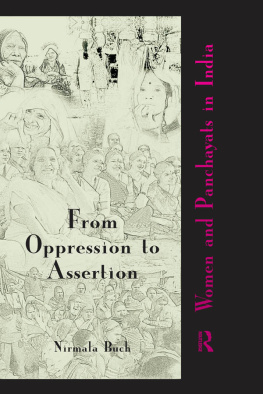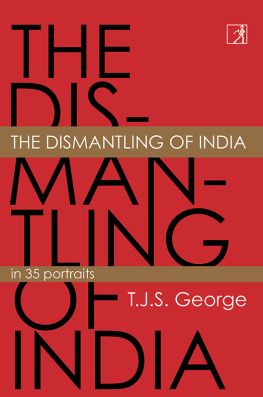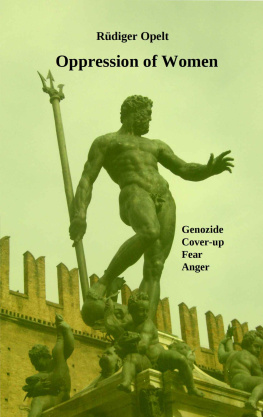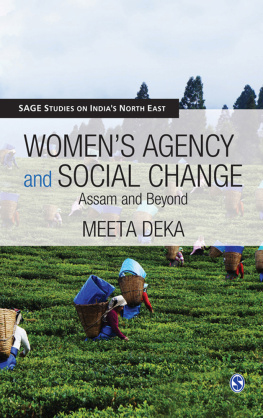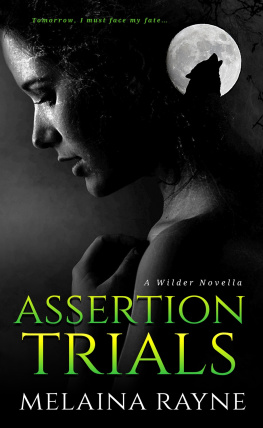George S. Everly Jr. - From Oppression to Assertion: Women and Panchayats in India
Here you can read online George S. Everly Jr. - From Oppression to Assertion: Women and Panchayats in India full text of the book (entire story) in english for free. Download pdf and epub, get meaning, cover and reviews about this ebook. year: 2013, publisher: Routledge, genre: Politics. Description of the work, (preface) as well as reviews are available. Best literature library LitArk.com created for fans of good reading and offers a wide selection of genres:
Romance novel
Science fiction
Adventure
Detective
Science
History
Home and family
Prose
Art
Politics
Computer
Non-fiction
Religion
Business
Children
Humor
Choose a favorite category and find really read worthwhile books. Enjoy immersion in the world of imagination, feel the emotions of the characters or learn something new for yourself, make an fascinating discovery.
- Book:From Oppression to Assertion: Women and Panchayats in India
- Author:
- Publisher:Routledge
- Genre:
- Year:2013
- Rating:5 / 5
- Favourites:Add to favourites
- Your mark:
- 100
- 1
- 2
- 3
- 4
- 5
From Oppression to Assertion: Women and Panchayats in India: summary, description and annotation
We offer to read an annotation, description, summary or preface (depends on what the author of the book "From Oppression to Assertion: Women and Panchayats in India" wrote himself). If you haven't found the necessary information about the book — write in the comments, we will try to find it.
From Oppression to Assertion: Women and Panchayats in India — read online for free the complete book (whole text) full work
Below is the text of the book, divided by pages. System saving the place of the last page read, allows you to conveniently read the book "From Oppression to Assertion: Women and Panchayats in India" online for free, without having to search again every time where you left off. Put a bookmark, and you can go to the page where you finished reading at any time.
Font size:
Interval:
Bookmark:

by Routledge
912915 Tolstoy House, 1517 Tolstoy Marg, New Delhi 110 001
by Routledge
2 Park Square, Milton Park, Abingdon, OX14 4RN
Star Compugraphics Private Limited
D156, Second Floor
Sector 7, Noida 201 301
A catalogue record of this book is available from the British Library
| Sarpanchpati/pradhanpati | Spouse of a woman chairperson of village panchayat. She is called Sarpanch in Madhya Pradesh and Pradhan in Uttar Pradesh |
| Janpad Sabha | A unit of local self-government at the intermediate level between a district and a village created under the Central Provinces and Berar local Self Government Act 1948 |
| Zila Panchayat | District panchayat |
| Panchayat Samiti | Panchayat at the intermediate level, between the district and the village |
| Pancha Parmeshwar | Panchayat member as God |
| Gram Sabha | The general assembly of the village consisting of its registered voters |
| Gram Swaraj | Village self-rule as propagated by Mahatma Gandhi |
| Pradhan | Elected chairperson of the village panchayat |
| Sathin | lit. woman friend. A Sathin is a honorary worker in the WDP who works as a friend of women and helps in awareness generation and conscientisation |
| Thakurs | Kshatriya Rajput, the warrior caste; also a title adopted by them |
| Gond | Name of an ethnic group; a tribe in central India included in the list of Scheduled Tribes in the Indian Constitution for special attention |
| Bhil | A tribe of central India who speaks the Bhili language |
| Bhilala | A small tribe found in central India; commonly considered to be a mixed group which had sprung from the alliances of immigrant Rajputs with the Bhils |
| Amin | A local official responsible for revenue collection and keeping accounts |
| Panchas | Members of the village panchayat |
| Farman | A royal edict |
| Kshetra Samiti | lit. area committee; refers here to a panchayat body at the intermediate level of a development block in Uttar Pradesh |
| Mahila Samakhya | lit. women speak for equality. Name of a programme of education for women's equality |
| Satnami | lit. true name. Refers to the socio-religious movement in Chattisgarh founded by Guru Ghasidas. Its followers are almost exclusively from a particular scheduled caste and limited to Chattisgarh plains |
| Bhaiya Raja or Munna/Munni | lit. royal brother and little prince/little |
| Raja | princess; used to address feudal family members with royal suffix even for children |
| Praja | Subject people of rulers |
| Bhil Meenas | Name of a tribal group of Rajasthan |
| Garasias | A tribe said to be of Rajput descendant mainly living in southern Rajasthan |
| Pramukh | lit. Chief or principal person. Here chairperson of district Panchayat |
| Janpad Panchayat | Block level panchayat |
| Adhayksha | Chairperson |
| Pooja | worship |
| Up-Sarpanch | Vice chairperson of the village panchayat |
| Sarpanchi/Sarpanchai | Exercise of powers and performing the duties of the post of Sarpanch |
| Patwari | Village Land Records Officer. |
| Pracheta | A woman field worker above the level of Sathin in WDP who is appointed for raising awareness |
| Mukhya Sevika | Head female village level worker. |
| Jeevan Dhara scheme | Jewan Dhara scheme meaning water as life line has been part of a bigger rural wage employment programme of JRY (Jawahar Rozgar Yojana) in which irrigation wells were constructed on lands of persons belonging to Scheduled Castes and Scheduled Tribes. |
| Nyaya Panchayat | A panchayat performing judicial functions. |
| Jajam | Big cotton carpet spread on the ground used for sitting in village common meetings. Sometimes refers to such a common meeting. |
| Zila Pramukh | District panchayat chairperson |
| Parti-bazi | Party politics |
| Para-teacher | A less qualified teacher who is paid lower remuneration |
| Shikshakarmi | lit. education worker/teacher. Appointed on special, fixed contract terms |
Font size:
Interval:
Bookmark:
Similar books «From Oppression to Assertion: Women and Panchayats in India»
Look at similar books to From Oppression to Assertion: Women and Panchayats in India. We have selected literature similar in name and meaning in the hope of providing readers with more options to find new, interesting, not yet read works.
Discussion, reviews of the book From Oppression to Assertion: Women and Panchayats in India and just readers' own opinions. Leave your comments, write what you think about the work, its meaning or the main characters. Specify what exactly you liked and what you didn't like, and why you think so.

